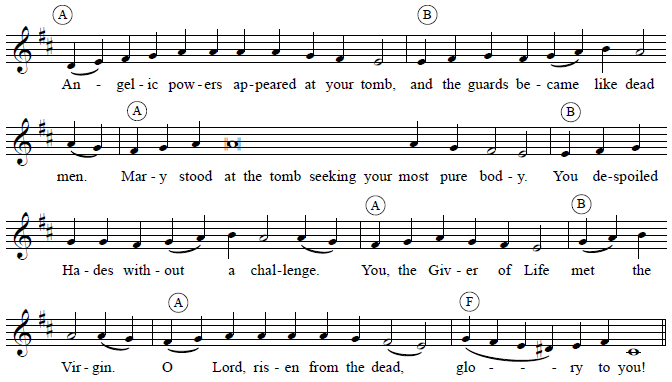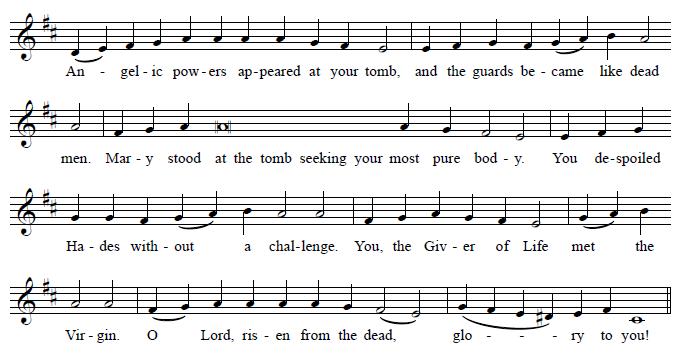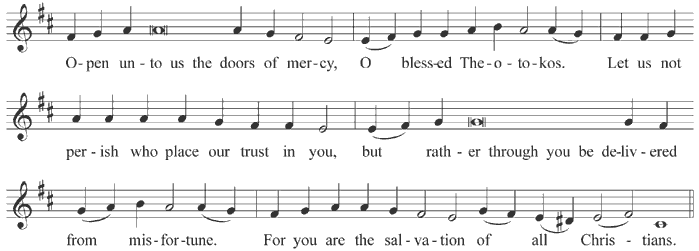The Tone 6 Troparion Melody
This prostopinije melody is used to sing troparia in tone 6. (Kontakia in Tone 6 have their own melody.) This article will show you how to sing hymns to the Tone 6 troparion melody.
Please note: This article assumes you are familiar with the material taught in the MCI Online course, Introduction to Church Singing. If you have difficulty reading the music notation, please review the MCI website articles on musicianship.
The Sunday troparion
There is only one Tone 6 troparion in our Divine Liturgies book: the troparion of the Resurrection in tone 6, which is sung every eighth Sunday throughout the year as part of the cycle of eight tones. It can be found on page 152 in our Divine Liturgies book. This troparion should be memorized.
This melody is entirely scalewise, except for the concluding phrase, and is quite easy to sing; the only tricky point to watch out for is the rhythm at the end of the second repeating phrase.
The structure of the melody
The melody consists of two repeating phrases (A and B) and a concluding phrase (F):

In other prostopinije melodies that use two alternating phrases, the second phrase is a musical "answer" the first, and there is a slightly longer pause at the end of the B phrase. This is not the case with the Tone 6 troparion melody. When you get to the "limping" quarter notes at the end of the B phase:

always sing them a tempo, then pause no longer at the bar line than you did at the end of the A phrase. Listen to the Tone 6 Sunday troparion in Slavonic to see how this works.
If you have trouble singing this rhythm correctly, try practicing it with a sing half note replacing the two quarter notes:

Then go back and sing it as written:
The final (F) phrase always follows a B phrase. It repeats the last three notes of the B phrase, then raises the tonic pitch (do) by a half step (to di):

before ending re - mi - ti. Remember that by ending on ti, we give an "incomplete" sound to the troparion, signalling that the service continues.
The general moleben
At the general moleben "for any intention", there are three troparia sung to the Tone 6 troparion melody (though one is called a kontakion). Of these, the most important is the last one, the "general theotokion" or common hymn to the Mother of God:
The initial two notes of the A phase are omitted, and the last B phrase is combined with the final or F phrase, but otherwise this exactly follows the pattern of the Sunday troparion in Tone 6.
The hymn that comes before it is the "general kontakion":
Again, there are slight variations, but this is the same basic melody.
The situation changes with the very first troparion at the general moleben, which manages to combine the beginning of the Tone 6 samohlasen melody with the Tone 6 troparion melody; this melody will be covered elsewhere. For now, listen to all three hymns, paying close attention to the second and third hymns, which are shown above.
Listen to the troparia from the general moleben
When several troparia are sung - the lesser doxology
The music for the general moleben (on pages 441-449 of the Divine Liturgies book) also shows how to sing the lesser doxology
Glory to the Father, and to the Son, and to the Holy Spirit, now and ever and forever. Amen.
before troparia in Tone 6. Here is how the "Glory" is sung:

and here is the "Now and ever." (Compare this to the A and B phrases above to see how it is "built" from these shorter melodies!)

Alternate versions can be found in the MCI Cantor Verses book, in the Tone 6 section under "Resurrection Tone."
Learning the melody
- Sing through Sunday troparion in Tone 6 repeatedly. Be careful to sing the quarter notes at the end of the each B phrase without slowing down, and try to make the pauses between all the phrases approximately the same length..
- Practice the second and third troparia at the general moleben ("Lord, have mercy on us" and "Open unto us the doors of mercy").
- If your parish celebrates Vespers, memorize the festal theotokion in tone 6 ( Sunday Vespers book, page 91).





